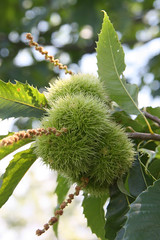 American chestnut (Castanea dentata), once a common canopy tree in the eastern U.S.
American chestnut (Castanea dentata), once a common canopy tree in the eastern U.S.
Photographers: Erin & Lance Willett.American chestnut was once the dominant tree in mid-Atlantic hardwood forests—comprising as much as 35 percent to 50 percent and sometimes more of the canopy.1 2
Today, there are virtually no mature American chestnuts remaining in these forests.
What killed the chestnuts? A fungus called chestnut blight (Cryphonectria parasitica).
Before the blight, the fast-growing American chestnut provided foliage, fruits, and living wood as food for bears, turkeys, native insects, and many more animals. Its dependable, abundant crops of chestnuts were an important food for Native Americans, and later, European immigrants who incorporated them into Christmas traditions.
It easily survived wildfires and outbreaks of native insects and diseases. Its durable, high quality wood was widely used in construction and carpentry. But since the 1930s, it has all but disappeared. Store-bought chestnuts today come from European stock or hybridized strains.
 A pathogenic fungus causes chestnut blight, a lethal infection that has devastated the American chestnut tree (Castanea dentata) across its range in the eastern United States.
A pathogenic fungus causes chestnut blight, a lethal infection that has devastated the American chestnut tree (Castanea dentata) across its range in the eastern United States.
Photographer: Flickr user Vicky SommaThe chestnut blight fungus was apparently unwittingly brought to the U.S. on highly resistant Japanese and/or Chinese chestnut trees in the late 1800s, and spread undetected for many years throughout the U.S. via the nursery trade.
The fungus enters wounds on the tree and grows in and under the bark, forming cankers on the stems. The tree eventually dies back to the roots. Chestnut blight is easily spread on the feet of any insect or other animal that walks across the cankers.3
In some cases the roots continue to send up sprouts, which succumb to the fungus before they are old enough to reproduce. After the loss of American chestnut, drought-tolerant oaks appear to have increased where American chestnuts once grew.4 5 Oaks can host the fungus without getting sick, so there is a continual source of the fungus to infect new chestnut sprouts.
Scientists are working to develop blight controls and to breed a resistant strain of American chestnut, with the goal of restoring the majestic chestnut to eastern forests of North America.
- 1. . 1910. The ecological plant geography of Maryland; coastal zone; eastern shore district.
- 2. . 1974. Plant communities on a quartzite ridge in Chester County, Pennsylvania. Proceedings of the Pennsylvania Academy of Science . 48:101-106
- 3. . 1997. Chestnuts and the Introduction of Chestnut Blight.
- 4. . 1973. Distribution of major forest species in southeastern Pennsylvania. Ecological Monographs. 43:303-327
- 5. . 1978. A study of forest communities in southern Chester County, Pennsylvania. Proceedings of the Pennsylvania Academy of Science 52:37-44.


